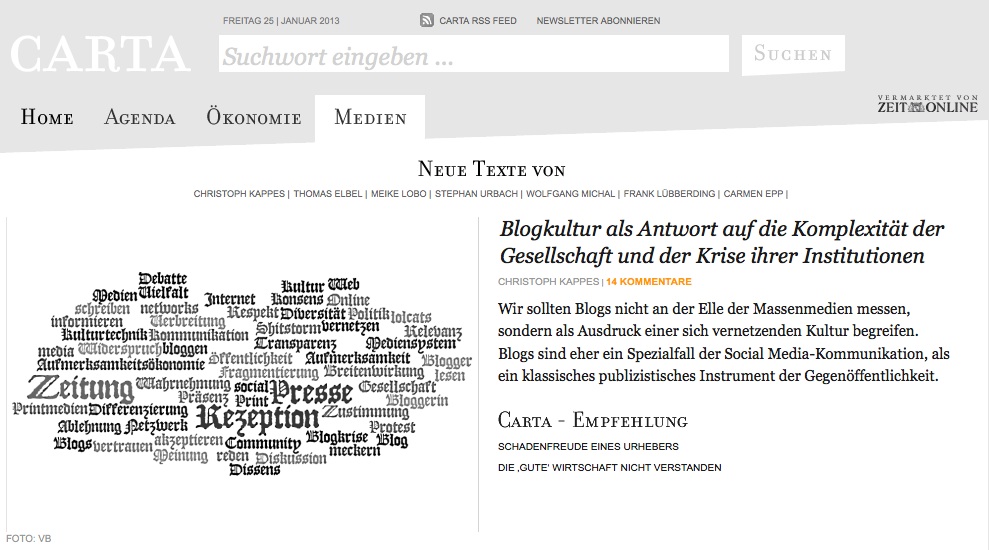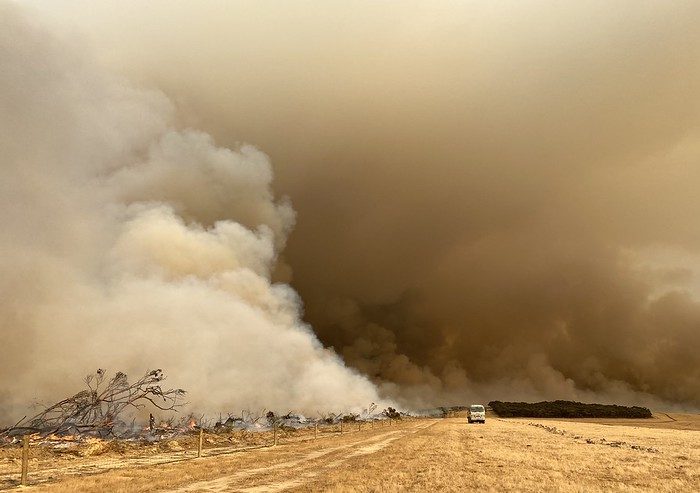
A devastating bushfire season in Australia at the end of 2019 rounded off a year of extreme weather events worldwide, which prompted some media to reassess their coverage of climate change.
Though climate change is now regularly acknowledged to be “the defining story of our time” by media worldwide, many European media outlets have yet to formulate a clearly defined editorial policy on covering the issue, a new survey by the European Journalism Observatory has found.
In particular, public service broadcasters (PSBs) are often reluctant to be seen as adopting a campaigning stance, instead insisting that their policy with regard to reporting on climate change is no different from their editorial policy on any other topic.
Many maintain that the same fundamental editorial criteria – such as impartiality, objectivity and public interest – apply equally to all topics covered, and that climate change is treated no differently to other issues.
Newer start-up media organisations, on the other hand, have long led the way in tackling the subject and in most cases have a clearly articulated editorial policy relating to it.
However, 2019 appears to have marked a turning-point in the approach of several media outlets to the topic. Europe experienced its hottest ever year, and the relentless accumulation of extreme weather events worldwide meant that the issue of climate change moved steadily up the news agenda.
For the European Journalism Observatory (EJO), this provided an opportune moment to take stock of how the European media cover climate change.
Six EJO partners (the Czech Republic, Germany, Italy, Poland, Ukraine and the United Kingdom) took part in a study looking at how different types of media – in most cases, a public service broadcaster, a legacy media outlet and an online news outlet – cover the issue.
A general pattern emerged of greater recognition of the seriousness of climate change and the importance of ensuring that audiences are fully informed of the implications of this. However, this pattern is not always consistent across the continent and across different types of media.
Covering Climate Now
One yardstick used to give a rough indication of the degree of importance attached to the topic was whether the news outlets surveyed had signed up to the Covering Climate Now (CCN) initiative launched in spring 2019 by the Columbia Journalism Review and The Nation.
The aim of the CCN project is to increase both the amount and quality of climate change coverage and thereby raise public awareness of the issue. By November 2019, more than 350 news outlets worldwide had signed up to the initiative, pledging to make the climate story a routine part of daily news coverage.
The UK daily the Guardian – which has for some years treated climate change as a priority coverage area – quickly became involved in the CCN project as lead media partner. Several news outlets in other countries surveyed as part of the EJO study are also media partners in the CCN initiative.
Among the countries we surveyed, the only PSB to have signed up so far to the CCN initiative is Italy’s RAI. But despite the apparent reluctance of PSBs in general to adopt a campaigning ethos – and thereby possibly compromise their reputation for impartiality – most are clearly fully aware of a responsibility to inform their audience of the scale of the challenge posed by climate change.
They are also aware of the challenge posed by changing news consumption patterns. While older audiences across Europe still rely on TV as their main source of information, PSBs are increasingly struggling to retain younger audiences, and with this in mind are making greater efforts to address issues that most urgently concern the younger generation.
Earlier studies such as James Painter’s “Something Old, Something New: Digital Media and the Coverage of Climate Change” (2015) found that digital-born players – whose target audience tends to be significantly younger than the audience of legacy media – employed a much wider range of novel reporting styles, formats, and tone than more established media.
EJO’s survey suggests that while newer media may still lead the way in finding imaginative angles and engaging with their audience via social media, many long-established media outlets have learned lessons in presentation from their younger rivals and increasingly look for a wider range of angles to the story and rely on digital tools to tell it.
East-West divide
Something of an East-West divide emerges in the European media’s coverage of climate change. This may reflect the fact that Central-Eastern European countries such as the Czech Republic and Poland are still heavily dependent of fossil fuels for their energy needs. Many Czechs and Poles believe that their economies will be disproportionately affected by a switch to greener energy sources, which could explain why media towards the conservative end of the spectrum in both countries are reluctant to frame climate change as an emergency.
For the media in European countries outside the EU, there is an even more stark perception that much of the audience is too preoccupied with the challenges of everyday life to be able to spend time worrying about the environment. A journalist on the Ukrainian news website Ukrainska Pravda Zhyttia told EJO that for many of its readers, the struggle to put food on the table meant that climate change was not one of their most pressing concerns.
 United Kingdom
United Kingdom
BBC – guidelines clarified
The BBC has over the past year or so made considerable efforts to give the issue of climate change due prominence, to tackle the subject from numerous angles in an innovative fashion and to provide its audience with useful advice on how lifestyle choices can make a real difference.
Previously, the corporation occasionally stumbled by allowing climate change deniers an on-air platform without challenging their views strongly enough or framing their remarks in such a way that the audience was left in no doubt that the interviewee was expressing a personal opinion that ran contrary to the scientific consensus.
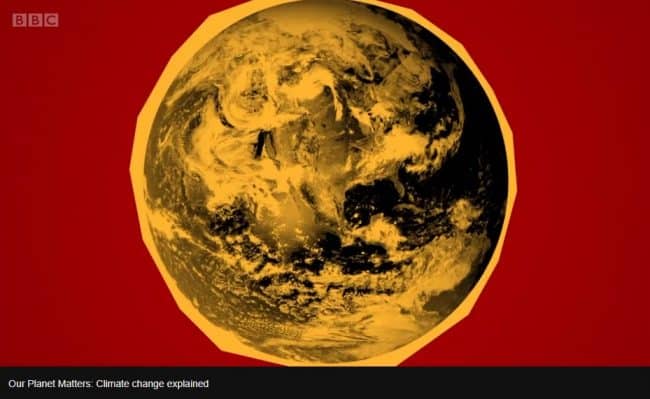
The BBC has launched a year-long series of special programming devoted to climate change.
Following a rebuke from the media regulator Ofcom over one such lapse, in the autumn of 2018 the BBC’s director of news and current affairs issued an editorial policy directive to all staff that restated the BBC’s position on impartiality and warned of the danger of enabling “false balance” on climate change.
The BBC did not respond to EJO’s request for comment on whether the clarification of its guidelines on impartiality marked a shift in its approach to climate change coverage.
However, 2019 saw some serious, in-depth coverage of the issue both on television and on the BBC’s news website, and a greater reluctance to give a platform to climate change contrarians. One landmark programme was the documentary “Climate Change: The Facts”, fronted by the highly respected presenter David Attenborough, who stressed the urgency of the situation.
And in January 2020, the BBC announced plans for a year-long series of special coverage of climate change under the title “Our Planet Matters”.
The Guardian – campaigning stance
Left-of-centre newspaper the Guardian has long taken an unashamedly campaigning approach in its climate change coverage.

The Guardian was one of the first media outlets to adopt a more campaigning stance.
According to the Guardian’s environment editor, Damian Carrington (as quoted by James Painter in “Poles Apart: The international reporting of climate scepticism”), a real “step change” in its climate change coverage took place as far back as 2008, when the environment team was expanded and the Guardian first articulated its philosophy of not confining its climate change stories to a special “ghetto” section, but of constantly highlighting the bigger picture by emphasising the links to water, energy, food, population and other issues.
Following the launch of the Covering Climate Now initiative, the paper announced that it had updated its style guide and was now recommending that journalists and editors use “terms that more accurately describe the environmental crises facing the world.” It said that “climate emergency, crisis or breakdown” should henceforth be preferred to “climate change”, as in the words of editor-in-chief Katharine Viner: “The phrase ‘climate change’… sounds rather passive and gentle when what scientists are talking about is a catastrophe for humanity.”
The Guardian subsequently announced that there had also been a change in thinking over the kind of images that were appropriate to illustrate the climate story. Picture editor Fiona Shields explained that after seeking advice from the research organisation Climate Visuals, the paper had concluded that pictures of people affected by the consequences of climate change would communicate more directly the impact of the climate emergency than pictures of polar bears on melting ice sheets.
Vice UK – “top priority”
As a digital-born news company aimed mainly at younger people, Vice UK is typical of such platforms in having a strong focus on the environment. Its parent company, the Vice Media Group, defines the role of all Vice outlets as providing “the definitive guide to an uncertain world”, and in September 2019 Katie Drummond, Senior Vice President of Vice Digital, declared that coverage of environmental issues was core to the mission of this sector.
Vice Media as a whole has signed up to CCN, and Vice UK, like its Italian counterpart (see below), has played its part in making coverage of the climate crisis a priority. One of its key reporting themes is “Save Yourselves”, under which heading it regularly carries campaigning articles reminding its readers of what action they can and should take to mitigate the threat to the planet.
Vice UK editor-in-chief Jamie Clifton told EJO that becoming a partner to the CCN initiative had been a very natural move. “The environment is a topic that we all care deeply about as the editorial team, and it’s something that we’d made a conscious decision to cover more… it was already a top priority editorially anyway.”
Like all Vice media outlets, Vice UK places great emphasis on visual modes of communication (both photos and videos), relies heavily on social media channels to reach out to its readers, and constantly seeks to involve its audience in the debate.
Vice UK occasionally draws on content originated by other Vice offices, for example “Which of Your Favourite Apps and Websites Are the Worst for the Environment”, which was first published in Vice Italy’s “Motherboard” section.
 Czech Republic
Czech Republic
For many years, Czech media were split down the middle over the topic of climate change. Mainstream media largely ignored the subject, leaving it up to independent media outlets with a more progressive outlook (those whose readership consisted mainly of young urban professionals) to cover it. However, in 2019 all Czech media, regardless of type and political perspective, treated the climate crisis as one of their main themes.
However, when it came to discussing editorial policy on the issue, mainstream and conservative media were on the whole reluctant to engage, while media with a more left-wing outlook were more willing to explain their approach to EJO.
Mainstream media – no specific policy
Editors at the public broadcaster Czech Television and the conservative daily Hospodářské noviny gave only brief and somewhat evasive responses to EJO’s question on editorial policy with regard to climate change coverage. Though these outlets do cover the issue of climate change and take it seriously, neither has a specific policy on it, saying that the same editorial guidelines on matters such as impartiality, objectivity and public interest apply equally to all topics. The Czech Television editor appeared to be barely aware of the Covering Climate Now initiative, and the editor of Hospodářské noviny did not reply to this question.
Editors at the Czech Radio channels Radiožurnál (the main news channel) and Plus (devoted to in-depth analysis of current affairs and discussion programmes) did not respond to EJO’s queries. Erik Tabery, editor-in-chief of the long-established news magazine Respekt, was reluctant to divulge any information about the weekly’s editorial policy with regard to climate change. Though Respekt was one of the first Czech media outlets to cover environmental issues (which it has been doing since the 1990s), like other mainstream media it prefers to project a neutral stance rather than risk coming across as a campaigning medium.
Digital media – “The future is now”
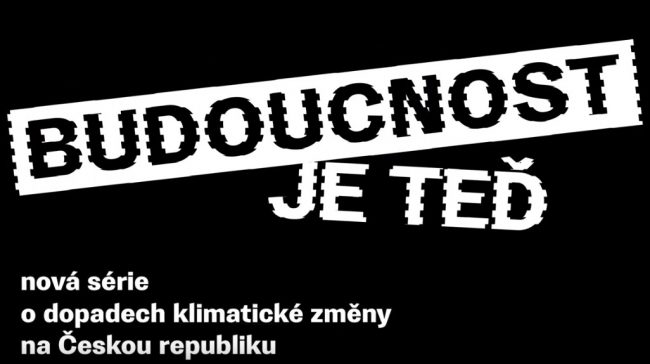
A2larm’s series “Budoucnost je teď” [The future is now] stresses the urgency of the situation.
While Deník Referendum is so far the only Czech media outlet to have signed up to Covering Climate Now, another left-wing outlet, A2larm, takes the issue equally seriously. A2larm has covered the topic extensively as part of an ongoing series of articles under the heading “Budoucnost je teď” [The future is now]. Editor-in-chief Jan Bělíček told EJO that A2larm had also decided to use the term “climate crisis” consistently in preference to “climate change”, which it felt failed to convey sufficiently strongly the seriousness of the situation.
Both Deník Referendum and A2larm believe they have a mission to provide a counterbalance to the powerful vested interests that control much of the Czech media and to what they see as the “apathy” of the mainstream media.
 Germany
Germany
ARD – “part of public service duties”
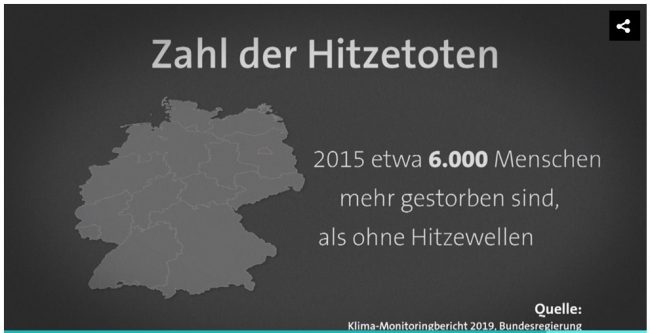
An ARD documentary spells out the human costs of heatwaves: 6,000 extra deaths in Germany.
Like many PSBs elsewhere, the German public broadcaster ARD does not have a specific editorial policy for climate change coverage. However, it does devote considerable airtime to the issue, and the guidelines setting out ARD’s journalistic priorities for 2019/20 note that the network’s flagship science programme „W wie Wissen“ is to have an increasing focus on “challenges of the modern world such as climate change.”
ARD editor-in-chief Rainald Becker told EJO that the broadcaster uses a variety of journalistic formats, including news programmes, documentaries and political magazines, to cover the topic. Becker said that “as climate change coverage is part of ARD’s public service duties and ARD covers it extensively,” he saw no need for the network to join a global initiative such as Covering Climate Now. He said the main challenge for journalists was to approach the subject from as many different angles as possible and to explore the way in which it has an impact on so many other areas, such as politics, sociology, ethics, science, technology and ecology.
Der Spiegel – “not just a scientific topic”
Der Spiegel, Germany’s highest-circulation weekly news magazine and one of the most widely read German-language news websites, does not have a specific editorial policy on climate change coverage. However, Kurt Stukenberg, deputy head of the science desk, told EJO that Der Spiegel’s science editors now increasingly use the term “climate crisis” instead of “climate change”.
Though Der Spiegel’s coverage is mainly event-driven, Stukenberg insists that the science desk keeps the topic constantly under review. He says the approach is not to focus purely on new temperature records, but to explain the impact of such phenomena on all areas of life. “The climate crisis is not just a scientific topic; it has for a long time now affected politics, society and the economy, of course, as well as culture and other areas,” he told EJO.
In September, when Der Spiegel lent its support to the Covering Climate Now initiative, running a week of high-profile climate coverage as a curtain-raiser to the UN Climate Action Summit in New York.
Süddeutsche Zeitung – “solutions-focused approach”
Süddeutsche Zeitung, one of Germany’s largest daily newspapers, likewise has no specific editorial policy regarding climate change coverage. Vivien Timmler, the editor who covers the topic of sustainability on the business desk, told EJO that the same quality criteria apply here as to any other subject. As with Der Spiegel, Süddeutsche Zeitung’s coverage of climate change tends to be event-driven. However, during the summer of 2019, the paper published two specials on the theme, each consisting of between ten and twenty articles.
“It’s quite a challenge to attract as many readers as possible and to make them receptive to the topic of climate change”, Timmler told EJO. “It’s quite a balancing act to delve more deeply into what can be a very complex matter, without putting off readers who aren’t already well informed.” She added that it is also a challenge to make readers aware of some of the less optimistic scientific predictions, while still convincing them that it is not yet too late to act. “This takes us into the realm of constructive journalism and requires a solutions-focused approach – avoiding moralising, but adopting a tone that readers will respond to.”
 Italy
Italy
Rai Radio 3 – “a priority”
In Italy, the main television news channel of the public broadcaster Rai plus two Rai radio stations, Radio 1 and 3, have signed up to the Covering Climate Now initiative. In particular, the cultural and scientific channel Rai Radio 3 regards climate change coverage as a priority.
Rossella Panarese, the editor and presenter of the daily science programme Radio3 Scienza, told EJO: “We believe it’s important to address both the complexity of the data and state of knowledge, and also the social and cultural aspects”.
Though Rai Radio 3 focuses mainly on reporting the latest findings of scientific research, it does not shy away from the complexity of the issue or from giving practical advice. Its programmes often offer suggestions on how people can modify their behavior for the sake of the environment, including information about manufacturing processes and the impact of our travel and tourism habits.
Panarese acknowledged that there has been a noticeable “Greta effect” – as a result of the worldwide impact of young Swedish climate change campaigner Greta Thunberg – and that the engagement of young people in the protest movement has been an important story for Radio3 Scienza to tell.
She also noted that broadcasters are often expected to treat divergent viewpoints as all being equally worthy of attention. The assumption that scientific facts could be debated in the same way as political parties or football teams was symptomatic of “a loss of confidence in science,” she added.
Corriere della Sera – news interest comes first
EJO spoke to Paolo Virtuani, a journalist with Corriere della Sera, one of Italy’s oldest national newspapers. Virtuani, who has been covering climate-related issues for the paper for more than 20 years, told EJO that Corriere della Sera does not have a formal editorial policy on climate change, and that it aims “to cover events (of all kinds) not on the basis of preconceived ideas but on the basis of news interest.”
However, climate-related stories have often been featured on the front page, and Virtuani told EJO that the Fridays for Future movement inspired by Greta Thunberg “has certainly boosted interest in environmental issues.” He added that there had been a positive public response to Corriere della Sera’s climate change coverage: “Readers are very interested in these issues and our articles dealing with them are among the most read online.”
Vice Italy – “not just an environmental issue”
Vice Italy devotes considerable space to the issue of climate change, particularly on the Italian version of Vice’s science and technology section Motherboard. It also currently hosts a dedicated “climate change” section.

Vice Italy has a special Facebook group devoted to the climate crisis.
Giulia Trincardi, Motherboard editor for Vice Italy, explained to EJO how the editorial policy works: “For the last few years, Vice Italy‘s editorial policy with regard to climate change has been mostly about acknowledging published scientific studies with international resonance, directly interviewing scientists whenever possible, and focusing on Italian issues related to climate change.”
Vice Italy’s climate change coverage has in recent years expanded to include projects such as a video documentary about the effects of climate change on Venice and the launch of a Facebook group in which readers can discuss climate issues with journalists. Trincardi insists that Vice Italy sees climate change “not simply as an environmental issue, but also as a political and a social one.”
Along with all other Vice outlets worldwide, Vice Italy has signed up to the Covering Climate Now initiative. In line with this commitment, it produces special content which is translated into other languages and re-used by other members of the Vice group of news outlets.
 Poland
Poland
Public broadcaster – no response
EJO asked the public service broadcaster – both the television service Telewizja Polska (TVP) and Polskie Radio – to comment on its climate change coverage policy, but received no response from either branch.
However, two independent media outlets, the daily newspaper Gazeta Wyborcza (the biggest broadsheet in the country) and the online news and information service Onet (one of the top Polish “horizontal” portals, with around 12 million users monthly), were prepared to respond to EJO’s questions.
Gazeta Wyborcza – priority issue
Michał Olszewski, the editor-in-chief of Gazeta Wyborcza’s “Gazeta na zielono” [Gazeta in green] section, told EJO that climate change was one of the most important topics ever covered by the paper, which is why it is prepared to devote so much space to the issue.
Like the Guardian, with which it has collaborated on a number of other joint journalistic ventures over the last few years, Gazeta Wyborcza had no hesitation in signing up to the Covering Climate Now initiative. Also like the Guardian, it has modified its use of terminology in response to the urgency of the situation, and now uses the term “climate crisis” instead of “climate change”.
The online edition of the paper also has a special section called “Wyborcza na zielono,” which is dedicated to the environment and looks at the issue from a local, national and global perspective. Olszewski told EJO that as well as making the environment a priority issue, Gazeta Wyborcza was also experimenting with new and engaging ways of telling the story.
Onet – focus on scientific evidence

Onet’s “Oddychaj Polsko” [Breathe, Poland] project seeks to raise awareness of environmental issues by focusing on the country’s battle with smog.
However, Kozanecki also said that Onet sometimes took the initiative by trying to persuade readers of the importance of factors affecting the climate, even though it is clear that such topics are not always well received. Onet has not signed up to the CCN project.
Kozanecki said that Onet strives to base its climate change reporting purely on scientific evidence, and avoids giving space to pseudo- or para-scientific voices and narratives. In November, in conjunction with the air quality monitoring company Airly, Onet launched a project called “Oddychaj Polsko” [Breathe, Poland] intended to raise awareness of the serious levels of air pollution in the country.
 Ukraine
Ukraine
The Ukrainian media do not in general devote much space to the topic of climate change. Coverage is almost entirely event-driven: most media outlets respond to major headline-grabbing events such as Greta Thunberg’s speech to the UN climate summit in September, but there is little consistent in-depth coverage of the underlying issues.
Ukrainian EJO asked three media outlets – the public broadcaster UA:PBC, the weekly magazine Ukrainskyi Tyzhden [Ukrainian Week] and the news website Ukrainska Pravda Zhyttia [Ukrainian Truth Life] – to outline their editorial policy regarding climate change. The public broadcaster and Ukrainska Pravda Zhyttia said that they did not have a specific policy on how to cover the issue, but the editor-in-chief of Ukrainskyi Tyzhden, Dmytro Krapyvenko, gave a more considered response, suggesting that some thought has gone into how to approach the topic.
UA:PBC – lack of quality expertise
Mariya Frey, the general producer for regional broadcasting, responded to EJO’s questions on behalf of the public broadcaster. She confirmed that there was no specific policy relating to climate change coverage. Frey said that although UA:PBC’s journalists did report the topic, the lack of quality expertise on the issue in Ukraine was an obstacle to more in-depth coverage.
Ukrainskyi Tyzhden – avoidance of “hype”
The weekly’s editor-in-chief, Dmytro Krapyvenko, told EJO that several issues of his magazine had been devoted to climate change and had focused on the connection with Ukraine’s own environmental problems. He emphasised that Ukrainskyi Tyzhden’s main aim was “not to be a mainstream media outlet which follows the fashion but to puzzle out the problem and discover different views on it. Our mission is to create trends, not to follow them.”
Krapyvenko said that the weekly preferred a sober and objective approach, and tried to avoid falling into the trap of what he described as “hype” and “dogmatics”. He said that Ukrainskyi Tyzhden took its cue from the conservative German daily Die Welt, which he said had a balanced approach and was good at presenting the issue in a broader context.
Krapyvenko noted that Ukrainskyi Tyzhden often publishes Ukrainian translations of articles that originally appeared in Die Welt, and that the sober tone of these articles was a good fit with his own publication. In his view, news outlets should seek to avoid the twin extremes of alarmism and denialism and instead approach the topic “with caution, avoiding dangerous simplifications and generalisations.”
Ukrainska Pravda Zhyttia – little original content
The journalist Iryna Andreytsiv responded to EJO’s questions on behalf of the news website Ukrainska Pravda Zhyttia. Andreytsiv said that the outlet relies heavily on translations of items from foreign media in its coverage of the theme, and only rarely commissions original content on the topic of climate change.
She explained that the main reason for this was a lack of resources, but that a shortage of journalists with adequate knowledge of the subject and the indifference of the Ukrainian public were also factors.
Andreytsiv said that few Ukrainian journalists had the technical expertise to understand the topic themselves, and many struggled to make it accessible to a wider public. She added that it was also a challenge to convince readers who were struggling to make ends meet that they should care about the issue. “When someone doesn’t have enough money to buy food, it’s difficult to persuade them that climate change is important. You have to be able to make clear to them the link between climate change and our basic human needs.”
About the project
Do European media take climate change seriously enough? is part of an ongoing collaborative journalistic research project by the European Journalism Observatory.
It can also be read on the following EJO sites:
- German: Nehmen europaeische Medien den Klimawandel ernst genug?
- Italian: I media europei prendono abbastanza sul serio il cambiamento climatico?
- Czech: Změna klimatu v evropských médiích. Berou ji redakce dostatečně vážně?
- Polish: Czy europejskie media traktują zmiany klimatu wystarczająco poważnie?
- Ukrainian: Чи достатньо уваги європейські медіа приділяють змінам клімату?
Methodology
The analysis was conducted at six universities and research institutes across Europe. Contributors looked at three different kinds of media outlets in their respective countries (in most cases, the public broadcaster, a legacy print outlet and an online outlet). In cases where the outlet’s editorial policy with regard to climate change was not clearly set out as part of its mission statement, contributors asked senior editorial staff to outline their policy on the issue. These editors were also asked to identify what they see as the main challenges faced by journalists covering climate change.
EJO network
Written by
Paula Kennedy, editor of EJO English, Reuters Institute for the Study of Journalism, University of Oxford
Contributors
Miloš Hroch and Sandra Štefaniková, Charles University, Prague, EJO Czech Republic
Tina Bettels-Schwabbauer, Erich-Brost-Institut TU Dortmund, EJO Germany
Philip Di Salvo and Antonio Nucci, Università della Svizzera italiana, Lugano, EJO Italy
Adam Szynol and Michal Kuś, Wrocław University, EJO Poland
Halyna Budivska, National University of “Kyiv-Mohyla Academy”, Kiev, EJO Ukraine
Acknowledgements
Special thanks to Richard Black, Scott Brennen, James Painter, Mike Schäfer and Meera Selva for their suggestions and advice.
Main image: Kangaroo Island bushfire, Australia / Photo by robdownunder / Source: Flickr / Licenced under CC BY-NC-ND 2.0
Other images: Screenshots from Facebook (Vice Italy’s climate crisis group) and from BBC, Guardian, A2larm, ARD and Onet websites
If you liked this story, you may also be interested in How Vice, BuzzFeed, and the Huffington Post Report Environmental Issues.
Sign up for the EJO’s regular monthly newsletter or follow us on Facebook and Twitter.
Tags: campaigning journalism, climate change coverage, climate change reporting, Covering Climate Now, engaged journalism, false balance, impartiality, public service broadcasters, science journalism










































